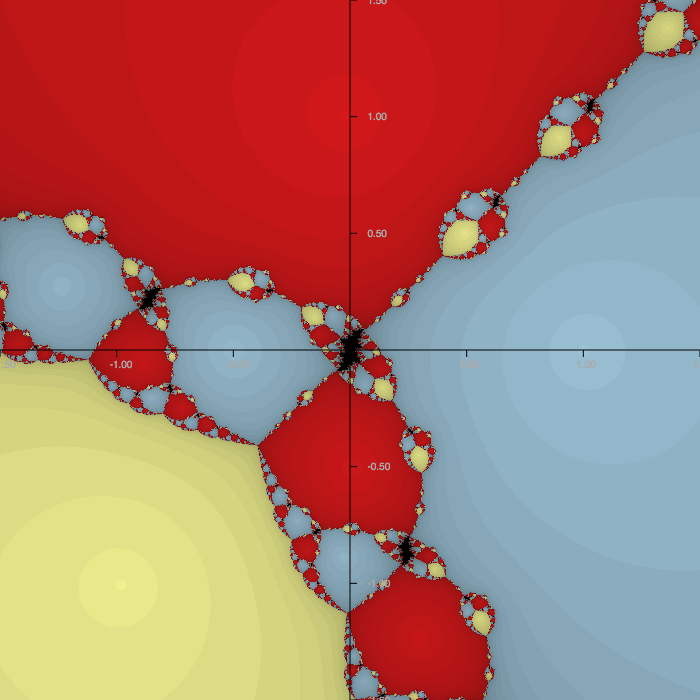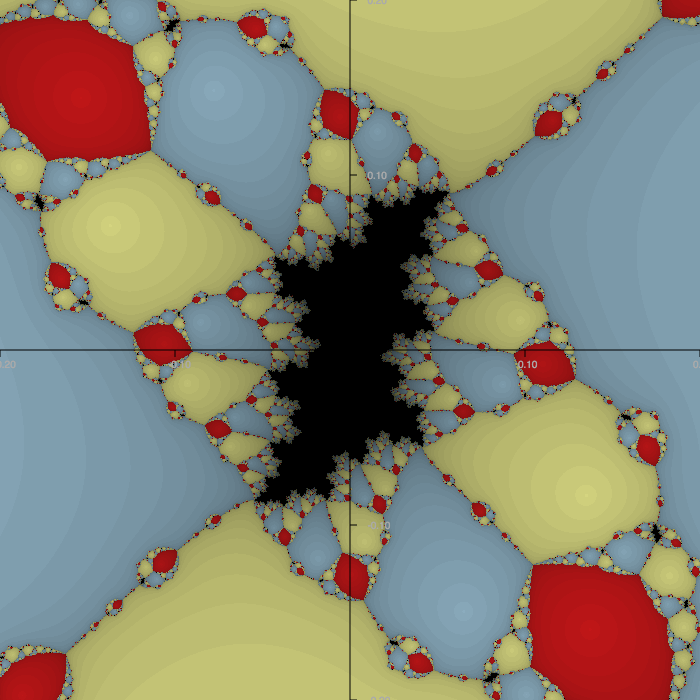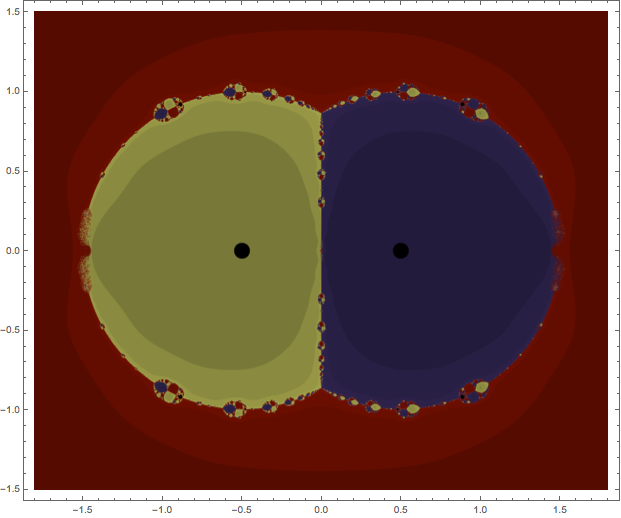I am looking for a degree 3 polynomial $P$ whose associated Newton's method $z \mapsto z - P(z)/P'(z)$ has a Siegel disk. Is there an explicit example of such polynomial $P$?
2 Answers
Implementing Alexandre's suggestion, I found that for $\lambda\approx 0.483096 + 1.00504\ i$, we have $$ \begin{align} P_{\lambda}(z) &= (z - 1)\ (z + 1/2 - \lambda)\ (z + 1/2 + \lambda) \\ &\approx \left(-1.02672+0.97106\ i\right)+\left(0.0267208-0.97106~ i\right)z+z^{3} \end{align} $$ is a good approximation to a polynomial whose corresponding Newton's method iteration function has a Siegel disk. While I found the parameters using Mathematica, you can use Sage to check them with this code.
Some dynamical pictures
The Newton's method basins of attraction looks like so:
If we zoom in on that component near zero, we see:
This certainly looks like a Siegel disk.
Finding the parameters
To find this thing, we first let $$ n_{\lambda}(z) = z-P_{\lambda}(z)/P_{\lambda}'(z) $$ and then $N_{\lambda}(z) = n_{\lambda}^3(z)$. We seek values of $z$ and $\lambda$ such that
$$\begin{align} N_{\lambda}(z) &= z \\ N_{\lambda}'(z) &= e^{2\pi i \left(\sqrt{5}-1\right)/2 }. \end{align}$$
There are other possible choices for the multiplier but I went with the golden angle.
Parameter pictures to help solve the system
To solve the system, we turn to Newton's method itself. More specifically, I used Mathematica's FindRoot command. To do so, we need initial guesses and we can use a picture to find those. First, the parameter space looks like so:
If we zoom in on the conspicuous looking blob at the top of the blue region, we see something like so:
The yellow dot at the center of the baby-brot is the super-attracting parameter $\lambda\approx 0.479 + 0.9997 \ i$ and satisfies $N_{\lambda}(0)=0$. It's not hard to find all such parameters since there's just a single equation of order 26 that needs to be solved.
If we zoom in a bit further, we see:
Now that second yellow dot on the cardioid oughtta be a good initial guess for the $\lambda$ we seek and a good initial guess for $z$ might be zero. Thus, using the initial guesses $\lambda\approx 0.4825 + 1.005 \ i$ and $z\approx 0.0$, I was able to find the more precise parameter stated at the beginning of this post.
-
1$\begingroup$ That's a very nice post! Perhaps consider adding this example it to wikipedia, and how you found it : en.wikipedia.org/wiki/Siegel_disc $\endgroup$ Commented Nov 1, 2018 at 6:53
-
$\begingroup$ @PerAlexandersson Thanks! I've never contributed to Wikipedia before; interesting idea, though. $\endgroup$ Commented Nov 1, 2018 at 12:46
-
1$\begingroup$ Indeed, that works, if I compute a thousand iterates of 0.04im and close points by the Newton method, I can see the circles. I am a bit surprised, given that we are using an approximation of the coefficients of the correct polynomial. I expected such perturbation to change the multiplier and destroy the Siegel disk. $\endgroup$– coudyCommented Nov 2, 2018 at 21:31
-
$\begingroup$ @coudy Yes, I'm amazed too. I just tried it myself. Initially, I grabbed the polynomial right at the top of this post and you could actually see divergence away from the disk after a couple thousand iterates. Using the $\lambda$ value from the linked code, which has more digits, the circle held for 100,000 iterates! I'm glad you like it!! $\endgroup$ Commented Nov 2, 2018 at 22:27
All fixed fixed points of the Newton map $N(z)=z-P(z)/P'(z)$ are superattracting. So there are no invariant Siegel disks. But of course there are periodic Siegel disks of periods greater than $1$.
For example, for a one parametric family of polynomials of degree $3$ considered in Douady and Hubbard, On the dynamics of polynomial like maps, Ann sci. Ecole Norm. Super., 18(1985), in section VI,
there are values of parameter which correspond to an attracting cycle of period 3. These values form a cardioid-like region, a part of a "baby Mandelbrot set". On the boundary of this cardioid-like region, the multiplier of the 3-cycle takes all values of absolute value $1$. So you have a 3-cycle of Siegel disks for an appropriate value of this multiplier. (There are such multipliers that all holomorphic germs with this multiplier have a Siegel disk, for example, $\exp(\pi i\sqrt{2}).)$
-
$\begingroup$ Thanks. I had a look to the paper of Douady and Hubbard. So there is a parameter lambda such that the Newton's method associated to the polynomial P(z) = (z-1)(z+1/2-lambda)(z+1/2+lambda) has a period 3 Siegel disk. It seems quite difficult though to give an explicit value for lambda. The period 3 orbits are the solutions of a degree 24 polynomial, this can't be easily solved as a function of lambda. $\endgroup$– coudyCommented Oct 31, 2018 at 15:53
-
$\begingroup$ @coudy: I did not say it is easy, but with a computer should should be able to do this numerically. Write the multiplier of this 3-cycle, and then the equation that the multiplier is $=exp(\sqrt{2}\pi i)$. One should be able to solve this equation numerically, if this is what you want. $\endgroup$ Commented Oct 31, 2018 at 16:46
-
$\begingroup$ @coudy: perhaps the Newton method for a 4-th degree polynomial has a 2-cycle of Siegel disks. This, if true, will lead to an equation of smaller degree. $\endgroup$ Commented Oct 31, 2018 at 16:47
-
$\begingroup$ I wished I could write the polynomial on the blackboard. So be it. $\endgroup$– coudyCommented Oct 31, 2018 at 16:54
-
$\begingroup$ You will be able to write it on a blackboard, after you compute the coefficients with a computer. Moreover, once the polynomial is found, CHECKING that is really has a Siegel cycle (numerically) should be possible by hand. $\endgroup$ Commented Oct 31, 2018 at 17:47





